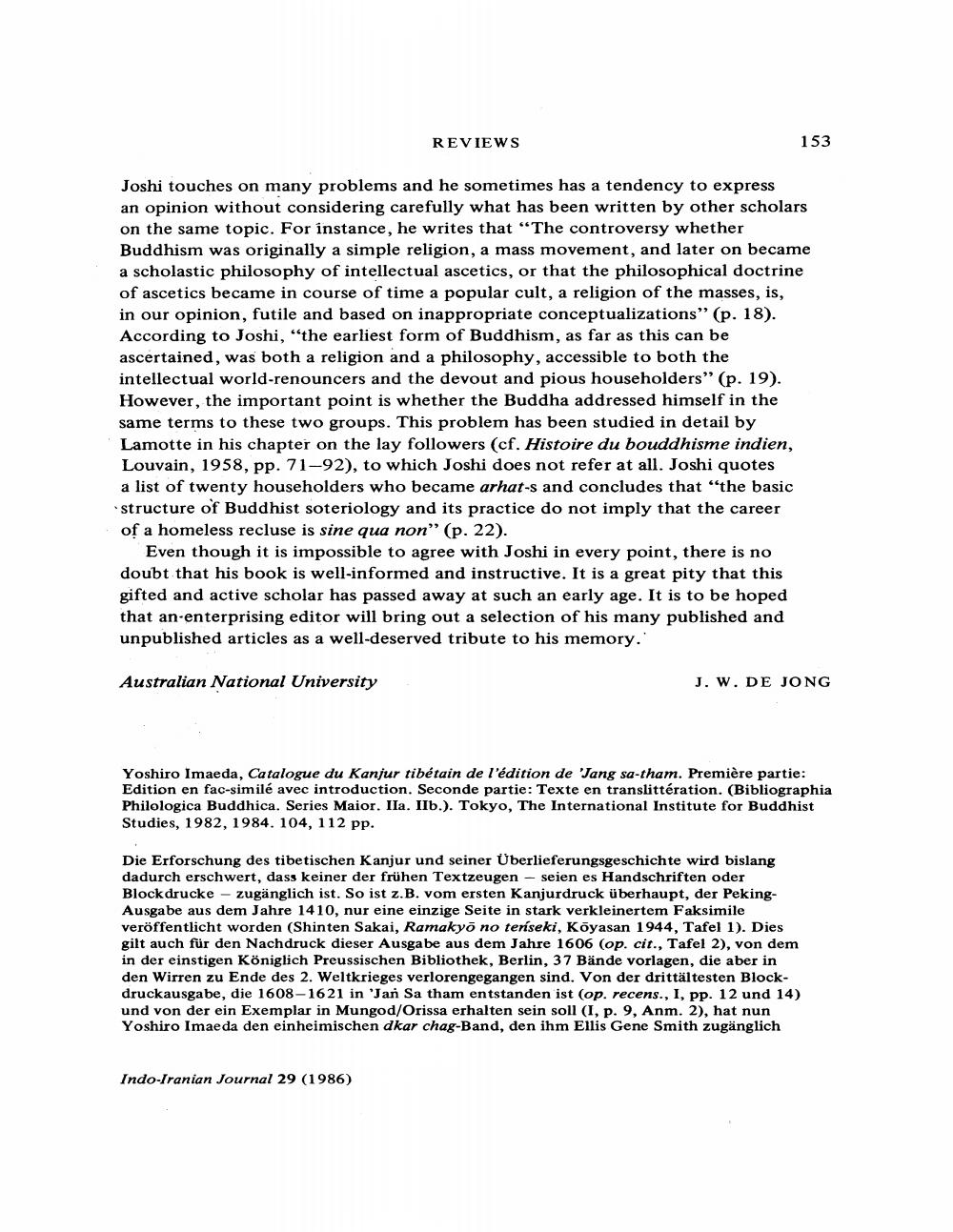Book Title: Reviews Of Diffeent Books Author(s): Publisher: View full book textPage 7
________________ REVIEWS 153 Joshi touches on many problems and he sometimes has a tendency to express an opinion without considering carefully what has been written by other scholars on the same topic. For instance, he writes that "The controversy whether Buddhism was originally a simple religion, a mass movement, and later on became a scholastic philosophy of intellectual ascetics, or that the philosophical doctrine of ascetics became in course of time a popular cult, a religion of the masses, is, in our opinion, futile and based on inappropriate conceptualizations" (p. 18). According to Joshi, "the earliest form of Buddhism, as far as this can be ascertained, was both a religion and a philosophy, accessible to both the intellectual world-renouncers and the devout and pious householders" (p. 19). However, the important point is whether the Buddha addressed himself in the same terms to these two groups. This problem has been studied in detail by Lamotte in his chapter on the lay followers (cf. Histoire du bouddhisme indien, Louvain, 1958, pp. 71-92), to which Joshi does not refer at all. Joshi quotes a list of twenty householders who became arhat-s and concludes that "the basic structure of Buddhist soteriology and its practice do not imply that the career of a homeless recluse is sine qua non" (p. 22). Even though it is impossible to agree with Joshi in every point, there is no doubt that his book is well-informed and instructive. It is a great pity that this gifted and active scholar has passed away at such an early age. It is to be hoped that an-enterprising editor will bring out a selection of his many published and unpublished articles as a well-deserved tribute to his memory. Australian National University J. W. DE JONG Yoshiro Imaeda, Catalogue du Kanjur tibetain de l'edition de 'Jang sa-tham. Premiere partie: Edition en fac-simile avec introduction. Seconde partie: Texte en translitteration. (Bibliographia Philologica Buddhica. Series Maior. IIa. IIb.). Tokyo, The International Institute for Buddhist Studies, 1982, 1984. 104, 112 pp. Die Erforschung des tibetischen Kanjur und seiner Uberlieferungsgeschichte wird bislang dadurch erschwert, dass keiner der fruhen Textzeugen - seien es Handschriften oder Block drucke - zuganglich ist. So ist z.B. vom ersten Kanjurdruck uberhaupt, der PekingAusgabe aus dem Jahre 1410, nur eine einzige Seite in stark verkleinertem Faksimile veroffentlicht worden (Shinten Sakai, Ramakyo no tenseki, Koyasan 1944, Tafel 1). Dies gilt auch fur den Nachdruck dieser Ausgabe aus dem Jahre 1606 (op. cit., Tafel 2), von dem in der einstigen Koniglich Preussischen Bibliothek, Berlin, 37 Bande vorlagen, die aber in den Wirren zu Ende des 2. Weltkrieges verlorengegangen sind. Von der drittaltesten Blockdruckausgabe, die 1608-1621 in 'Jan Sa tham entstanden ist (op. recens., I, pp. 12 und 14) und von der ein Exemplar in Mungod/Orissa erhalten sein soll (I, p. 9, Anm. 2), hat nun Yoshiro Imaeda den einheimischen dkar chag-Band, den ihm Ellis Gene Smith zuganglich Indo-Iranian Journal 29 (1986)Page Navigation
1 ... 5 6 7 8
